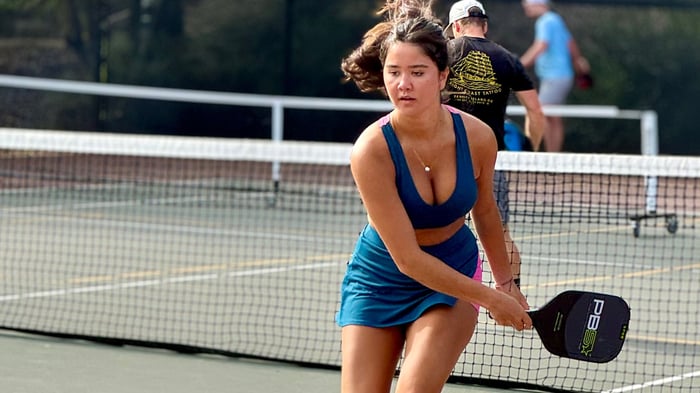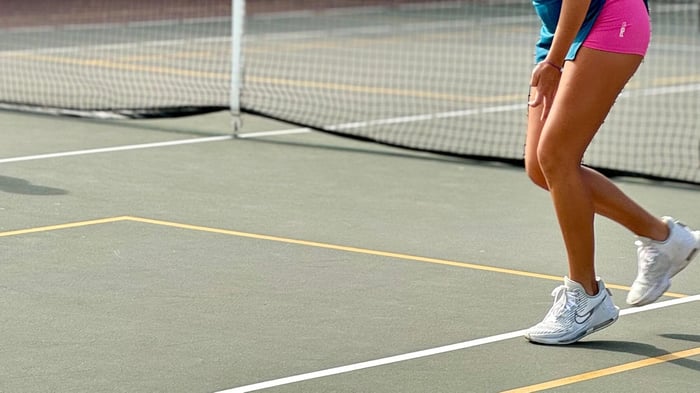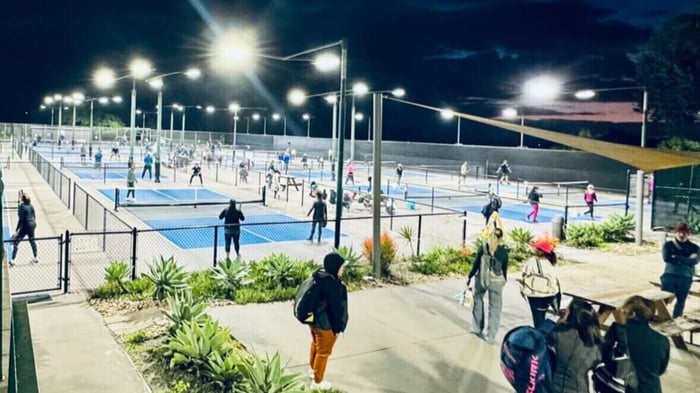Key takeaways:
A personalized pickleball practice plan with SMART goals can accelerate your progress and elevate your performance.
Aligning specific drills with your performance goals maximizes your practice efficiency and helps you build targeted skills.
High-quality gear, such as PB5 Court2 shoes, supports your skill development and enhances your game experience.
Some pickleball players improve by leaps and bounds while others stay stuck at the same level, and the difference often comes down to having a well-crafted training regimen. A structured approach to skill development can transform casual play into measurable progress on the court. By customizing your practice sessions to address your specific needs and goals, you can fast-track your improvement and reach your peak performance in pickleball.
That said, designing an effective skill-building routine isn't just about rallying for hours; it's about smart, focused training that pinpoints areas for growth and builds on your strengths. A personalized approach helps you maximize every minute of your practice time, whether you have a quick half-hour or a whole afternoon to dedicate. At PB5star, we recognize that quality training is key to enhancing your game, and we believe in the power of community to make that journey even more rewarding.
Assess your current skill level
You need a clear picture of where you're starting before you can create a pickleball practice plan that works for you. Take a moment to check in with your game and focus on what you need to train. It’s not about being perfect, it’s about knowing what’s working and what's not, and where your time on the court can count.
Here’s what you can do:
Reflect on your strengths and weaknesses: Consider what comes naturally and where you struggle during games. Be honest, this is about growth, not judgment.
Break your game into categories: Evaluate key areas like serving, returning, dinking, volleys, third-shot drops, footwork, and court positioning.
Use feedback from others: Ask a partner, coach, or teammate for input. Sometimes others notice habits or gaps that you might overlook.
Record a game or practice session: Watching yourself play, even briefly, can reveal much about your shot choices, movement, and patterns.
Identify one or two priority areas: Pick the most essential skills to focus on first. Targeted improvement builds confidence and momentum
Once you know where you stand, it becomes much easier to move forward confidently. A clear understanding of your strengths and growth areas gives your practice real direction—and that’s where progress starts. The more aware you are of your game, the more intentional and effective your training will be.
Set goals for pickleball practice
Setting goals for your pickleball practice gives each session a purpose. Instead of just hitting balls and hoping to improve, you’re showing up with a plan, and that kind of focus makes a big difference. Your goals don’t have to be complicated or long-term. They can be as simple as improving your serve consistency, hitting cleaner dinks, or staying in control during fast exchanges at the net.
Start small and build from there. Choose one or two things to focus on during each practice and track how they feel over time. Maybe you’re working on getting five third-shot drops in a row, or aiming to hit every return deep for one session. These short-term goals create momentum and keep you motivated. As you hit each target, you’ll build confidence, and soon you’ll be layering in more complex skills without feeling overwhelmed.
How to set SMART goals for more effective practice sessions
Setting goals is great, but setting the right goals moves your game forward. That’s where the SMART method comes in. It helps you focus your practice with clear, realistic targets to track and achieve. Instead of guessing through a session, you’ll know exactly what you’re working on and how to measure your progress.
SMART goals stand for:
Specific: Focus on a particular skill or outcome. Instead of "get better at pickleball," aim to "improve third shot drop accuracy”.
Measurable: Choose a way to track your progress. Set a target like "increase serve placement accuracy to 70% within the kitchen in matches within 2 months."
Achievable: Aim for challenging yet achievable goals. If you're new to the sport, start with "master the basic dink shot from both forehand and backhand sides" before aiming for advanced strategies.
Relevant: Make sure your goals align with your playing style and what you want to improve in real games. If you excel at the net but struggle with baseline play, prioritize groundstroke practice.
Time-bound: Give yourself a clear timeline to stay focused and motivated. Commit to "practice footwork drills for 20 minutes, 4 times a week for the next month."
When your goals are SMART, your practice becomes more focused, efficient, and rewarding. You’re not just hitting balls, you’re building skills with intention. These goals' clarity and structure help you stay motivated, track your growth, and celebrate real progress on and off the court.
Align goals with effective drills
Once you’ve got your goals in place, the next step is turning them into action, and that’s where the right drills come in. Drills give your practice structure and purpose, helping you target specific skills with honest intention. Instead of just rallying aimlessly, you're working on the parts of your game that need attention.
Refine your serve: Serve to specific targets to work on placement, depth, and consistency. Set up cones or use chalk marks to aim for different zones and vary spin or power with each round.
Master the volley: Practice quick-fire volley drills with a partner or coach at the net. Focus on soft hands, reaction time, and paddle control with rapid exchanges and directional targets.
Enhance footwork: Set up cone drills or ladder footwork routines to improve movement, balance, and court positioning. Combine footwork exercises with hitting drills to simulate real play conditions.
Perfect the dink: Drill cross-court and straight-on dinks, focusing on consistency and control. Use a kitchen line target to help maintain low, unattacked shots and work on patience in rallies.
Develop third-shot drops: Practice drop shots from different depths, especially after simulated serves. Alternate between cross-court and straight shots to build accuracy, touch, and transition confidence.
The best practice plans are built around drills that match your desired improvement. When your drills align with your goals, progress becomes more natural and more satisfying. Keep things focused, stay consistent, and you’ll start seeing real results every time you step on the court. Over time, those minor, targeted improvements will significantly increase confidence, control, and overall performance.
Track progress without overcomplicating it
It's easy to get caught up in trying to do everything perfectly, but tracking your progress doesn’t have to be a chore. A simple notebook, phone app, or even quick voice memos after a session can help you remember what felt good, what improved, and what still needs work. Keep it casual, jot down a few wins, note what you practiced, and check in on your goals every few weeks.
Staying motivated comes down to keeping things fresh and fun. If your practice starts feeling like a grind, it’s okay to mix it up. Add a new drill, challenge yourself with a mini goal, or take a light day to rally and enjoy the game. Burnout creeps in when things feel forced or overly rigid, so leave room to play with curiosity and creativity.
Frequently asked questions about pickleball practice plans
Everyone’s pickleball journey looks a little different, and it’s normal to have questions as you build your practice routine. Whether you're just getting started or trying to level up specific parts of your game, a few key answers can help you move forward with clarity and confidence. This section breaks down common concerns so you can spend less time second-guessing and more time getting better on the court.
What if I don’t have a partner to practice pickleball with?
Solo practice can still be super effective. Use a wall for volleys, practice serves to targets, or set up cones for footwork drills. Ball machines and portable nets also offer great flexibility. Even 20 minutes of focused solo work can sharpen your skills and build muscle memory that carries over into games.
How do I know which pickleball skills to focus on first?
Start with the fundamentals: serve, return, dinking, and third-shot drops. Choose one or two areas that feel shaky or inconsistent during play, and build from there. Your game will tell you what it needs, and by narrowing your focus, you’ll make faster progress without feeling overwhelmed.
Can I improve just by playing pickleball games instead of drilling?
Games help with strategy and pressure, but real skill-building happens in drills. Mixing both into your routine keeps your improvement well-rounded and steady. Drills build control and muscle memory, while gameplay allows you to apply those skills in real-time situations.
What’s the best way to stay motivated with my pickleball practice plan?
Keep it fun and flexible. Set small, achievable goals, switch up your drills, and celebrate wins, big or small. Practicing with purpose but without pressure keeps your love for the game strong. When practice feels like something you get to do, not something you have to do, it becomes easier to stick with and enjoy every step of the journey.
How can I measure my pickleball practice without tracking a bunch of stats?
Keep it simple. Pay attention to how you feel during play, are your shots more consistent, your movement more confident, your focus steadier? Progress often appears in these small shifts before it ever appears on a scoreboard. Trust the feel of your game as much as the results.
The more clarity you have about your practice, the easier it becomes to stay focused, motivated, and consistent. Keep asking questions, stay curious about your growth, and remember that your practice plan should work for you. Trust your process, enjoy the journey, and let the progress follow.
Chart your course to pickleball mastery
A personalized practice plan is your springboard to rapid improvement in pickleball. By setting SMART goals and aligning them with targeted drills, you're designing a winning strategy for success on the court. Progress in pickleball isn’t about doing more; it’s about doing what matters, with purpose and consistency.
A strong training routine keeps you motivated, sharp, and connected to your love for the game. Whether you're refining your serve, dialing in your dinks, or mastering movement, intentional practice makes the difference. At PB5Star, we support your journey with tips, tools, and inspiration to help you grow on and off the court.







